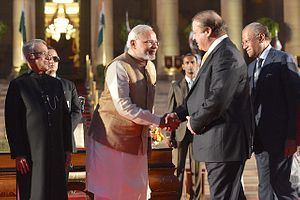Whenever we talk of the need for regional cooperation in South Asia, including closer ties between India and Pakistan, scholars and analysts tend to cite the examples of the EU, North America and ASEAN. What is overlooked is that in the years between 1947-1965, both economic and people-to-people links between the two countries were stronger than they are at present. More than the partition of 1947, it was the 1965 war that disrupted relations. Five decades later, it is worth examining some of the key features of the economic relationship as well as human ties.
Economic Ties
Much has been written about the robust economic relations that existed between India and Pakistan before 1965. In 1948-1949, for instance, India accounted for more than 20 percent of Pakistan’s exports, and more than 50 percent of its imports. While there was a dip in bilateral trade after India devalued its currency in 1949, the two countries signed a number of bilateral agreements (14). There are two other interesting aspects of the pre-1965 period. First, while there has been talks of Pakistan granting India most-favored nation status in recent years, progress has been halting. Yet during General Ayub Khan’s tenure, Pakistan did grant the equivalent of MFN to India in 1957. According to the agreement, India was to be given “treatment no less favourable than that accorded to the commerce of any third country.” The agreement was extended for three years. Similarly, Pakistani banks had branches in India (9) and vice-versa (1) in the pre-1965 phase. Although some banks on both sides have recently expressed interest in this, little progress has been made because of the unpredictable nature of the relationship.
Personal Experience
The level of people-to-people interactions in the pre-1965 period was significant. This has been examined by a number of historians and other scholars. During their work co-editing (with another Pakistani journalist Ali Farooq) the book Humanity Amidst Insanity, your correspondents learned how in the immediate aftermath of partition a number of individuals at least from the two Punjabs, crossed over for religious pilgrimages (especially Sikhs to Pakistan), sporting events (such as cricket and hockey matches), and most importantly to visit their erstwhile homes. They were warmly received, and in certain instances individuals even received the belongings they had left behind during partition. The book interviewed people on both sides, many of whom spoke about how they had emotional reunions with their friends and neighbors during such interactions.
The presence of a permit system (introduced in 1948 by India), and no visa regime until 1952, was one of the key factors made such interactions much easier, but it was by no means the only one.
Army
What was especially interesting was that during the course of another book, Warriors after War, a collection of interviews with retired defense officials from India and Pakistan, a number of officers stated that during the 1965 war they actually inquired as to whether any of their erstwhile friends and course mates were fighting on the other side!
The fascinating point is that after a traumatic partition which included not just the division of Punjab, a land that had been one cultural unit, wanton killing, and the migration of millions who had to leave their homes and property, both countries could maintain a civil relationship. So what happened after 1965? After all, a war had been fought in 1948 and partition was extremely violent, yet citizens on both sides managed to remain not just civil but exhibited great bonhomie.
Nationalism has definitely grown – reflecting a number of factors – but there is no reason for both countries not to strive for a civil/normal relationship, and they do not need to look far beyond the pre-1965 arrangement. Perhaps both governments need to explore the possibility of first breaking down the walls that prevent both trade and interactions between their citizens, and then the mental barriers can be addressed more purposefully. Over the past decade, some success has been achieved in rekindling transportation links between the Punjabs and Rajasthan-Sindh. But there is a long way to go before both countries reach the pre-1965 levels of connectivity.
Tridivesh Singh Maini is a Senior Research Associate with The Jindal School of International Affairs, Sonepat, India. Tahir Javed Malik is a senior Pakistani journalist. Maini and Malik have been co-editors of books on India-Pakistan relations including Humanity Amidst Insanity: Hope During and After the India-Pak Partition (UBS Publishers, 2008), and Warriors After War (Peter Lang 2011).

































